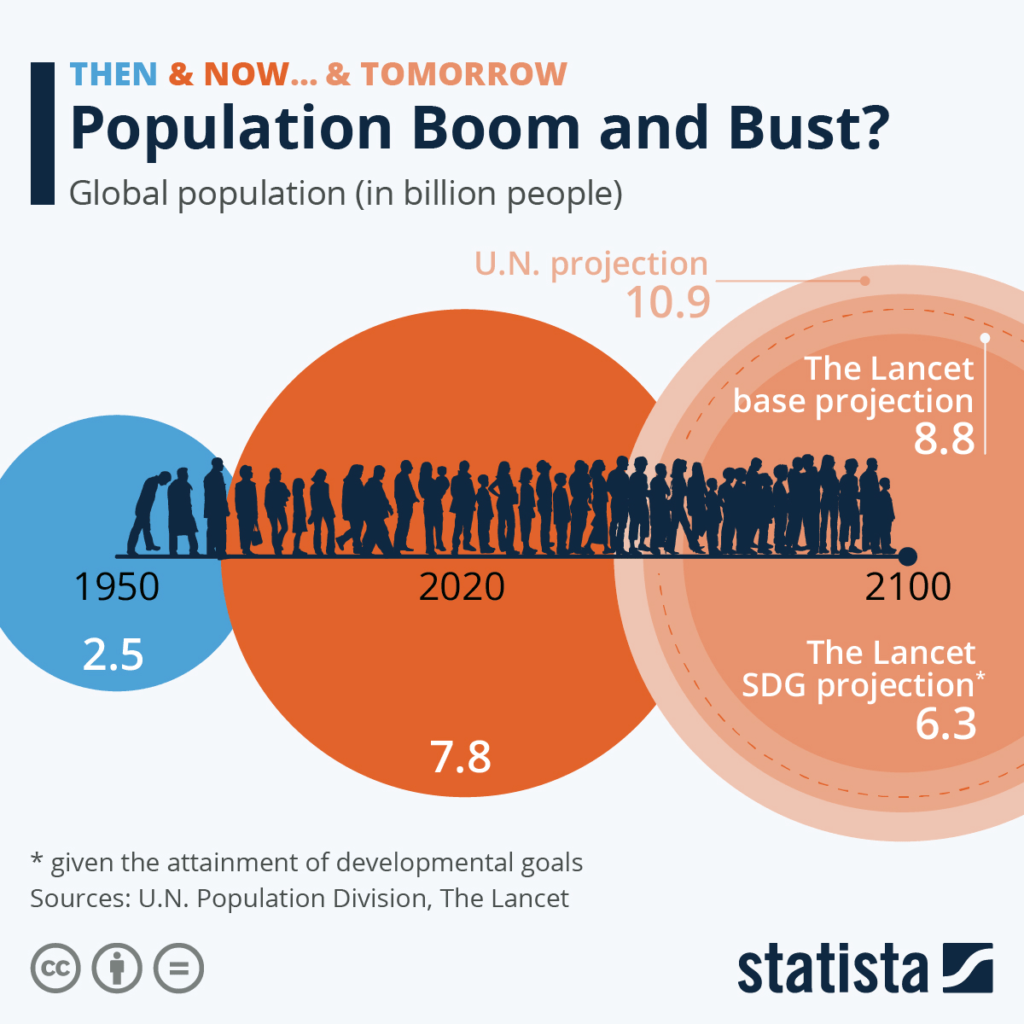The population boom in the 20th century was not a one-day miracle. Demographic transitions during the mid-18th century laid the foundation for this exponential growth. Until the mid-18th century, Europe and other parts of the globe faced high mortality rates due to inadequate hygiene practices, famines, failed harvests, and epidemic diseases. However, with the development of health infrastructures and better transportation, among other improvements, the death rate reduced.
During the 19th century, the child survival rate improved with the advent of vaccination for diseases like smallpox. The average death per 1000 citizens dropped from 30 to 15. However, the birth rate remained the same. Countries like Brazil, Congo, and South Korea had a fertility rate of 6 children per woman after the Second World War. The population explosion in African countries was much more intense as the extent of their demographic transitions occurred on a larger scale. Hence, the population reached staggering numbers in the 20th century.
Population Growth and Problems
The pool of resources has remained the same, but the number of seekers keeps trudging on. A simple example could summarize the problems of overpopulation. Many countries follow education-for-all policies to increase their literacy rates. It means that governments will divide the pool of educational resources among all applicants equally. But are there enough resources? There couldn’t be, especially in developing countries. So, even better prospects do not get enough support from the education system. Ultimately, educational institutions produce a better quantity of graduates and not better quality. It’s a trade-off between quality and equality.
What’s Coming?

After reaching the 8-billion milestone, most countries are entering the second phase (declining birth and fertility rate) of demographic transition. By 2100, the annual growth rate will be less than 0.1%, a sharp decline from the current rates. A question poses itself, “What is spearheading this coming decline?”
Education
Education, primarily, can play a significant role in the coming decline. Pregnancy poses a lot of complications for a mother. For instance, women with type-1 and type-2 diabetes can face problems during pregnancy which may increase the chance of birth defects in babies. The mother’s life may be at risk as well. In the past, people have often turned a blind eye to such simple facts. But there is a hub of information surrounding this topic today.
Now, people contemplate a lot while planning pregnancies. Until the mid-20th century, there were families with 8-10 children. The concept of wider family planning is why we see a maximum of two kids in a family today.
Contraceptives and Abortion
Effective birth control and contraceptives can safeguard women from unplanned pregnancies. The credit partially goes to education for making people aware of the importance and use of birth control.
Also, today women have the freedom of choice. During the years of peak sexism, when women had the “predominant” role of giving birth and taking care of children, abortion was highly frowned upon. In the case of unplanned pregnancies, women had to keep their babies. But today, most states have passed abortion laws. Resilient movements led by women have amassed much support in many countries. Hence, legalized abortions are leading to reduced birth rates.
Transition in Thought
If we look back 50 years from now, the life outline of most people in their early 20s was to graduate, get a job, marry, and start a family.
Some people might have had different interests, but having a family was always a part of the plan for most of them. However, today we see a different picture.
Gen Zs are more career-oriented. Most of them don’t think about getting married till their early 30s. They are more focused on building a career than starting a family. In addition, most of them have become a part of what we call “hustle culture” and have little room for a family.
Another fact about Gen Zs is some of them do not want children. People may have found it unreasonable or idiotic two decades ago, but the notion of not having kids is not uncommon today. Gen Zs are not motivated by the idea of leaving a legacy behind through their children.
Future Scenario
For years we have attributed our problems to population growth. Whether it be a reduction in natural resources or an increase in man-initiated disasters, population growth was at the core. But the tide has turned, and by the end of this century, the population will virtually stop growing. So we have another question, “Where are the celebrations?”
Concerns about Demographic Shifts
While poorer countries are trying to curb population growth, powerful ones are implementing pro-natalist policies to raise birth rates.
This transition in mindset is the result of concerns about demographic shifts. Countries are worried that population aging and decline will leave labor and skill shortages. Fewer experienced people will result in fewer outputs weakening economic growth. With declining birth rates, it will take longer to fill these gaps.
In addition, population troughs will put unsustainable fiscal pressure on governments, bring shifts in culture and ethnicities, and weaken the military prowess of countries. Professor Charles Jones, an economics professor at Stanford, published a paper titled “The End of Economic Growth?” He explained that living standards decline as overall productivity decreases and the numbers gradually dwindle. Economic growth requires novel ideas and adequate research. With the population declining at a global level, there will be even fewer people devoted to research causing slower progress in terms of technological evolution.
Also, demographer Wolfgang Lutz coined the “Low-Fertility Trap Hypothesis,” where low fertility in one generation passes on to the subsequent generations. This vicious cycle will continue until a downward spiral in population.
Final Thoughts
We have this trade-off between the two scenarios, and neither seems ideal. There has been an idea that a stable population can solve many complexities. However, past lessons have taught us that there is no such thing as a stable population. Many countries mandated a two-children policy, and now we have concerns about population decline.